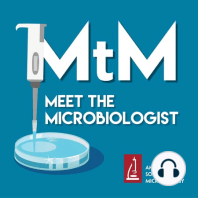26 min listen

083: Microbial communication via quorum sensing with Pete Greenberg
083: Microbial communication via quorum sensing with Pete Greenberg
ratings:
Length:
49 minutes
Released:
May 24, 2018
Format:
Podcast episode
Description
Pete Greenberg tells how bacteria can communicate based on cell density, a phenomenon he helped name quorum sensing. He talks about therapeutics based on quorum-sensing discoveries, and how studying bacterial interactions can be used to test ecological principles like cooperation and social cheating. Julie's biggest takeaways: Quorum sensing can be likened to an old-fashioned smoking room, where a few cigar smokers don’t affect the air quality, but as more smokers enter the room, it becomes beneficial to the group to open the window: a changed behavior that benefits the group environment. Differentiating waste molecules from signaling molecules is important to define specific quorum sensing. The experimental evidence that shows that molecules serve as quorum sensing signals that allow bacteria to respond at high density comes from social engineering experiments to identify ‘cheaters.’ Quorum sensing results in changes in gene expression that benefit the community but not necessarily individual cells. An example is antibiotics, which when made by a single cell aren’t at a high enough concentration to kill competitor microbes. As a group, all cells working together can produce a cloud of antibiotic that may be able to protect from competitors. The ability of microbes to receive or ‘eavesdrop’ on the signals produced may be cooperative, but is more likely competitive, giving the eavesdropper a competitive advantage by informing them about another species’ presence. If you knock out quorum sensing, you get abnormal biofilms, but it doesn’t ablate biofilms completely. Although a self-described disinterested high-school student, Greenberg signed up for a weekend field trip to get out of a test on a Friday. It was looking at animals in the intertidal bay of the Pacific Northwest that inspired him to be a biologist! Greenberg also credits his broad biology undergraduate training for preparing him to apply socioecology concepts to bacteria. Quorum sensing was originally called ‘auto induction.’ In the early 1990s, Greenberg was writing a minireview for the Journal of Bacteriology and wanted to think of a catchy title. As Greenberg remembers, coauthor Steve Winans explained the concept to his family, and his brother-in-law said “it’s like the bacteria need a quorum” - the birth of the term ‘quorum sensing.’ Featured Quotes (in order of appearance): “So-called ‘cheaters’ don’t respond to the signal, they’ve lost the ability to respond to the signal. The product that’s useful for the common good any more. They don’t pay the cost of cooperation but they can benefit by the cooperative activity of everyone else in the community...there’s a fitness advantage for cheaters in this environment.” “It’s a real case of convergent evolution. It’s important that the bacteria can do this, and these two really distinct types of [gram-positive and gram-negative] bacteria have evolved completely different mechanisms to perform quorum sensing.” “I think of bacteria as a way to study what is called ‘Darwin’s dilemma.’ If a cheater emerges among a population, it will have a fitness advantage over the population of cooperators. It should take over the population and ultimately cause the tragedy of the commons, where there are too many cheaters and not enough cooperators and the whole system collapses. Darwin’s dilemma is: how is cooperation stabilized? We know it exists and it seems like it shouldn’t - we can use bacteria to get at the rules.” “I got interested in [quorum sensing] because it was so cool!” “I had this idea, as we began to unravel quorum sensing in these marine luminescent bacteria, that any idea in biology that’s a good idea will occur more than once - but I didn’t have any evidence of that. For 15 years, my lab and essentially one other lab, Mike Silverman’s lab, were the only labs working on this. It was really the early 90s when our group and other groups started to realie that lots of bacteria do this. It’s one of those fantastic oddesies
Released:
May 24, 2018
Format:
Podcast episode
Titles in the series (100)
MTS18 - Elizabeth Edwards - Cleaning Up Solvents in Groundwater: Elizabeth Edwards knows that nothing is simple or easy when it comes to cleaning up toxic waste, but Edwards, a professor of Chemical Engineering and Applied Chemistry at the University of Toronto, is looking for ways to harness microbes to do our dirty w by Meet the Microbiologist